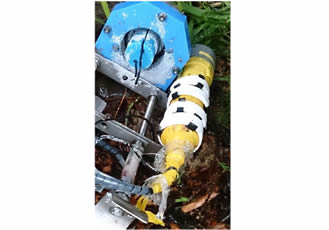Tsunami Sensor Recovered off Washington Coast

A pressure sensor used to measure and predict tsunamis was released from its moorings miles deep on the seafloor bottom after the mega-earthquake in Japan on March 11, 2011. Almost four years later, it washed up on-shore in Willapa Bay, Long Beach, Washington.
On January 22, 2016, scientists from Tohoku University, including Dr. Ryoto Hino, retrieved the Ocean Bottom Pressure (OBP) recorders and brought the equipment for teardown and examination to the tsunami pressure sensor manufacturer, Paroscientific, Inc., in Redmond, Washington. The externally mounted pressure sensor survived the severe earthquake, tsunami, and ocean journey back to its birthplace in perfect working condition. Data taken by the OBP was also intact and it recorded the earthquake, tsunami and part of the voyage across the ocean until the batteries internal to the OBP were exhausted. The tsunami pressure sensor has been returned to Japan for future deployments.
In addition to the instrument that was lost, two other OBP recorders survived the disaster and were recovered shortly after the disaster. As shown below, they yielded remarkable measurements. Two days prior to the mega-tsunami, the pressure sensors measured a seafloor change of 10 centimeters generated by a smaller earthquake of magnitude 7.3. This was followed by a further change of 1.5 centimeters over the next 2 days that was a pre-cursor to the 100 centimeters of seafloor movement generated by the 9.0 magnitude mega-earthquake.
Nano-resolution Sensors for Disaster Warning Systems have been developed to measure earthquakes, tsunamis, and severe weather. After the disaster on March 11, 2011, the $500M Japan Trench Tsunami Warning Network was established. This disaster warning system depends on the critical measurements from pressure sensors manufactured by Paroscientific, Inc. and seismic sensors from Quartz Seismic Sensors, Inc. in Redmond, Washington.
Quartz Sensors Solutions have been developed for dual-purpose disaster warning systems and geodetic measurement networks such as the Cascadia Sensor Network (CSN) Initiative. Disaster warning systems provide warning times from seconds to hours depending upon event location. The last Cascadia mega-disaster tsunami was in the year 1700 and the strain leading to the next big one is getting ever closer to the breaking point. These new quartz sensors and measurement methods will monitor the long-term strain buildup to provide better predictions and improved warning times.
Similar articles
More from ETLG Inertial Aerosystems
- Tsunami Sensor Recovered off Washington Coast 1st March 2016
- GG1320AN Digital Ring Laser Gyroscope 14th September 2015












Write a comment
No comments